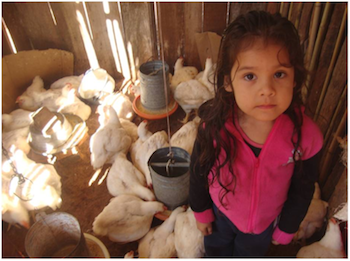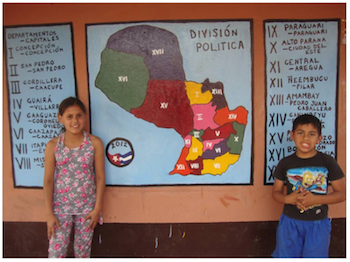Devon has lived and worked in Paraguay for more than three years, helping nearly 20 community groups, schools, and government agencies design and fund sustainable programs for economic and social development.
Does your nonprofit operate with half the staff and budget you really need to get the job done? Or are you a nonprofit helping the most “underserved,” “disadvantaged,” or “underrepresented” segments of the US population? If you have 501(c)(3) status, you probably fall into one or both of these categories.
Nearly all nonprofits operate under budget with scarce resources, and often benefit the neediest. US nonprofits might learn something by looking to those even poorer and less connected – they might learn something by looking to the developing world, for example Paraguay.
Paraguay is one of the poorest countries in the Americas, as well as one of the least connected to resources and most reliant on internal fundraising for basic programs and services. Following are five particular no-cost fundraising tips for US nonprofits from Paraguayan organizations that have even less and serve those even poorer but use ingenuity and true will to persevere to meet their goals.
1. Rely as completely on volunteerism as possible
US nonprofits focus on promoting volunteerism, but few rely on volunteers for fundraising. Developing world organizations have no choice; they often have no salary budget. Finding a great grant writer, major gift specialist, or even educated person to lead fundraising initiatives is usually impossible for them.
How do they use volunteers to fundraise? They make their beneficiaries do it. Nearly every public school in Paraguay makes students, from seventh grade on, create and be responsible for fundraisers for what Americans would consider routine services, even human education rights in some instances. Students ask classmates from more affluent families to donate items and then they raffle them, for example. Each student has to sell 10 tickets. The funds are necessary to pay for teacher salaries, books, and even chalk.
Nonprofits in the states often don’t directly involve beneficiaries as much as they could in raising the money for themselves, but this tactic has serious benefits:
- Involving beneficiaries directly invests them in the project.
- It looks really good to grant funders and major gift donors.
- It is a form of payment for those who cannot pay, and people should pay for services and resources! Giving them away for free can create dependency and does not solve the underlying problems.
2. Sell what you can
Those Paraguayan kids also get their moms together to make cakes, empanadas, or plates of food, and they pre-sell them door to door via ticket sales. Selling something is easy for an organization or nonprofit because it disconnects the contribution from the cause, and people are more likely to give if they get something in return.
Even if donors do not care about your cause, they might want a cake and will buy anyway! The Girl Scouts have figured it out with their cookies nearly a hundred years ago, but nonprofits in the States do not use this trick often enough.
You do not need to cheapen your cause and have a pancake breakfast if it is misaligned with your mission. You can match sales to your cause. Actively sell local art if you are a community crafts center. Get some volunteers together to make calls or use their Facebook and social media networks to sell services they can offer, like massages if one is a therapist, or Day off of Dinner Duty home meal deliveries. You can be really creative with this and make a lot of money for your cause.

3. Focus on one project, one goal
Paraguay’s idea of health access for all is a health post in districts that has some nurses that can take your temperature and maybe monitor your blood pressure. If you need anything beyond a consult, you have to pay (if you can find a doctor where you live). People that support entire families on $5-$10 a day cannot pay.
When someone gets in an accident or has a severe problem, the community comes together and has a festival fundraiser to e.g. “save Pablo’s leg.” That fundraiser focuses on one project, with one goal. The simplicity of it makes it entirely successful.
Nonprofits in the US can learn from this. Instead of having your Executive Director lay out your overall goals and mission for 20 minutes to potential donors, plan for an event that focuses on just one project and one simple goal.
For example, if your organization helps young boys go to a summer camp, have an entire event, “Send Alexi to Alexandria Camp! Make a Dream Come True.” The simplicity resonates with people, and you will still raise the money you need or cultivate the donors you need but in a more mission-pure way.
4. Keep it grassroots
Get a troop of those volunteers and beneficiaries discussed to go around and raise money. They can sell things; they can create online fundraiser pages. Paraguayan women’s groups are actually required by the government as part of funding requirements to try to sell soap, vegetables, or fresh eggs to educate the community about their particular missions and to unite them as a team.
This is a good step even if your organization is not grassroots. Why? Because people (funders) often want nonprofits to be grassroots. You look more connected to a cause if you are connecting people to your cause, and you are therefore more attractive to funders. Even if these measures do not raise a significant amount of funding directly, they are sending an important message to your donor constituency about your organization.
Keeping it grassroots appeals to the natural “do-gooder” sentiment that glues volunteers, funders, and you and your staff together to make your nonprofit system work!
5. Be realistic and work where the money is
Organizations in developing countries do not have a lot of options for core funding. They usually rely almost entirely on government support or support from one or two big funders, which often means they have to adapt their mission, vision, and goals to the goals of the resource makers because they have no choice. This is not the best option, obviously, but it does force an innate flexibility in program planning from which rigid board-answering US organizations can learn.
2010 was the bicentennial of Paraguayan Independence, and the Paraguayan government splurged for new paint for every school if they painted “bicentennial” with a flag-color emblem on their front entrance wall or door. Schools get nothing from the government, so they took the paint. They did use the paint and followed the rules, but then they used the leftovers to organize painting projects that had never existed for kids, like map-making, mural arts, and other creative projects. They adjusted their programs for the resources available.

Paraguayan school in Paso Yobai takes advantage of government paint improvement fund leftovers for a geography and arts map project.
Nonprofits could probably take more advantage of free gifts from government and other institutions, whether those are “handouts” like buckets of paint or stipends, volunteer support offers, or grants available for delivering certain objectives.
For example, if you run an after school enrichment program, and you focus on the arts, are you being flexible and checking to see if there are 1) free programs available via the local YMCA, 2) donations of supplies available from Home Depot and other stores, or 3) schools that are looking to partner with nonprofits to help meet education goals they are struggling with? If literacy is a problem in a nearby elementary school, and they are reaching out with small grants to innovative projects to help, you could have your youth at the afterschool center design books for kids to get that funding! You do not have to “sell out,” but there is usually a way to be a bit more flexible with your fundraising efforts.
If your nonprofit is struggling for resources, look to those even less fortunate in the developing world and borrow from their ingenuity! You might be able to make your life simpler in the process as well as pick up new project partners and innovate new program objectives that enable you to reach even more in need.
Images: © Devon Reeser
